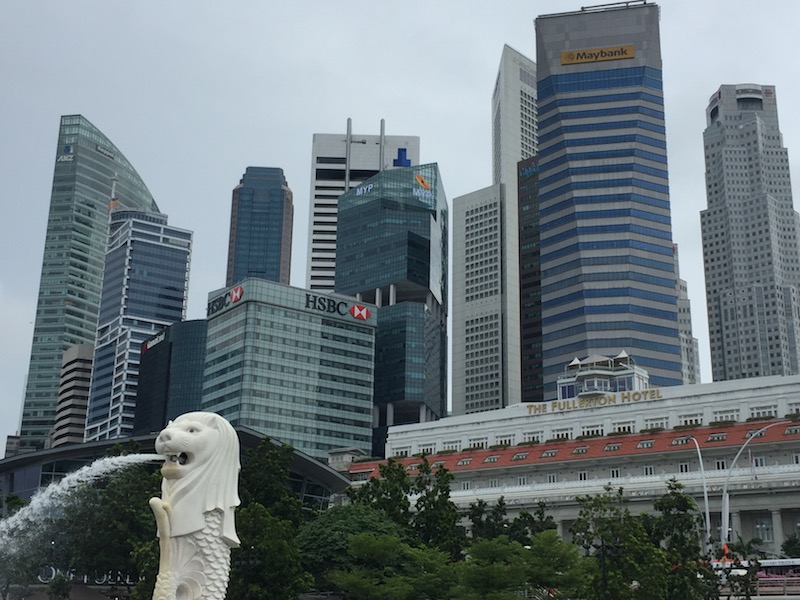There’s variety in Singapore’s weather. One minute it’s hot and sunny, the next there are downpours and crashes of thunder. On the day we were planning to visit the Botanic Gardens, it chucked it down and the buildings we’d got used to seeing from our bedroom window were lost in the murk. So we opted for the National Museum instead.
The museum has a much-praised history exhibit, which suited me fine as I’d been keen to find out more about how Singapore came to be beyond the simplistic tale of Sir Stamford Raffles’ arrival on the island. It’s housed in the former Raffles library and museum, which was built in 1887 in typical neo-classical and colonial style. But it’s also linked to a modern extension of glass and steel, which works very well indeed. At its heart is a magnificent dome with elegant stained glass panels.

The history exhibit turned out to be every bit as good as our trusty Lonely Planet guide had promised it would be. Despite being invaded by noisy and pushy school kids, the story was brilliantly told in a range of media from the time centuries ago when it was a thriving port known as Singapura. The advent of Raffles and his sidekick Major William Farquhar in 1819 was, not surprisingly, covered extensively, along with the colonial years that followed. Most fascinating was the collection of exhibits that told the disturbing story of Japan’s brutal and tyrannical occupation in the Second World War, the island’s slow recovery after peace had been declared and the departure of the British. What they didn’t explain was the fetish for naming so many things in Singapore after the said Raffles…

We resumed the story with the brief unification of Malaysia and Singapore in the 60s and independence in 1965. Another top-notch section talked to Singapore’s industrial boom and the challenge of housing so many people on such a small island. I was pleasantly surprised that the various exhibits were largely free of propaganda, bearing in mind that the rulers of Singapore have always been keen on control.
Somewhat less successful were the displays about how the nation was built in the first 10 years of independence, which seemed to be more about glorifying the state’s first Prime Minister Lee Kuan Yew, and the animated and ‘immersive’ animation Story of the Forest and Singapore, which was mostly aimed at children.

It was raining lightly as we left the museum, and we decided to walk down to Boat Quay via the historic Fort Canning Park. This strategic position overlooking the southern coast was home to Malay kings in the 14th century but later became a key defensive post for the colonial military authorities. Today, some of those old military fortifications remain amid the lush planting, giant sculptural trees and well-tended lawns.
At Boat Quay I tucked into excellent if fiery fried chicken and cold beers in a fine Korean known as Bonchon, and then in the drab but dry afternoon we walked to the fountain that goes by the name of Merlion, something of a symbol of Singapore and surrounded by snap-happy tourists. Quite why we bothered I have no idea. So we trudged back to the hotel via the colonial district, skirting the green park known as the Padang.

Evening found us in Chinatown, in Club Street, supping beers at Bar NKD while I struggled with the aftermath of too much chilli the night before. I think I spent as much time in the loo as I did in the bar but finally managed to escape so that we could eat at a plain and simple tapas place just round the corner. It wasn’t exactly local food but I needed something easy on the tum.
Rain threatened as we continued our exploration of the city’s nightlife. We stopped at the Tippling Club, the sort of pretentious cocktail bar that gets right up Graham’s nose. When they presented us with a menu composed solely of bits of cardboard that smelled like the taste of the cocktails, I feared he was going to punch someone.
A short walk away was Singapore’s main gay street, Neil Road, where we found the average Tantric Bar hidden behind a high wall. I couldn’t be sure whether this was designed to hide us depraved poofs from upstanding members of the straight community or to prevent local gay boys from having their sexual secrets discovered. Perhaps it was a bit of both… We sat outside drinking spirits while a mix of locals, ex-pats and tourists wandered in and out with partners, or on the hunt for one. I was surprised by how overt the bars were, bearing in mind that gay sex is illegal in Singapore.
It turned out that Tantric was one of several gay bars in the terrace, and we ended up in the Backstage Bar – a much better venue than its neighbour. Busier, velvety, very red and with a theatrical theme, we relaxed into it and drank ourselves drunk. Nice…

